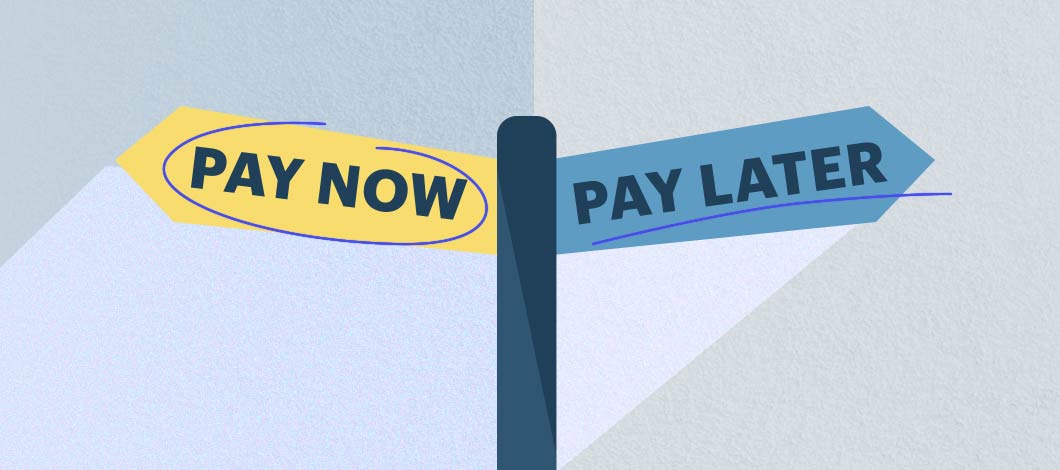Knowing how long you can defer tax payments and how to arrange a payment agreement with the IRS can provide you with the breathing space you need to stabilize your company’s cash flow and get your finances on track.
Here are 4 ways to defer your tax payment obligations.
1. Apply for a Short-Term Payment Plan
If you’re looking to defer a federal tax payment, the IRS offers taxpayers who expect to be able to pay their taxes within a few months a short-term payment plan. This option lets you avoid IRS collection notices and actions by agreeing to pay what you owe within a few months.
Short-term payment plans are for 120 days or less or up to 180 days in certain cases.
No Set-Up Fee, But Penalties and Interest Apply
A short-term payment plan doesn’t require you to pay a set-up fee, unlike longer-term payment agreements the IRS offers. However, you still must pay accrued penalties and interest until your balance is paid.
Qualifying for Short-Term Payment Arrangements
To qualify for a short-term payment plan that will allow you to defer tax payment to the IRS, you must owe less than $100,000 in combined tax, penalties and interest. In addition, you can only apply as an individual, not as a business. However, business owners who are sole proprietors or independent contractors can qualify by applying as individuals.
Applying for Short-Term Payment Plans
You can apply for a short-term payment plan online by filling out Form 9465 (Installment Agreement Request) or by calling 800-829-1040.
You will be prompted to create an account. You’ll need your photo identification and information to verify your identity, such as your Social Security number. You can pay directly from a checking or savings account, by check, by money order or by debit or credit card.

2. Apply for a Long-Term Installment Agreement
If you need longer than a few months to pay your taxes, another IRS payment deferment option is a monthly long-term installment agreement.
Set-Up, Interest and Penalty Fees
To defer your income tax payment with a long-term installment agreement, you’ll need to pay some set-up fees. Fees are lowest if you opt to pay your installments through automatic direct debits from a bank account and if you apply online. Fees are higher if you opt to pay through other options, which include:
- Direct payments from a bank account
- Online electronic payments
- Payments over the phone
- Check
- Money order
- Debit or credit card
Low-income taxpayers may qualify for a waiver on set-up fees. You can qualify as low-income if your adjusted gross income is at or below 250% of the applicable federal poverty level. If you have already applied for an installment agreement but you think you qualify as low-income, you can request a review of your status by submitting Form 13844 within 30 days from the date of your installment agreement acceptance letter.
While paying off your installment agreement, interest and some penalty charges continue to be added until your balance is paid in full.
Qualifying for Long-Term Payment Arrangements
If you owe $50,000 or less, you can generally qualify for a 72-month installment plan, which typically requires equal monthly payments.
If you need more than 72 months to pay or can’t make equal minimum payments, you may need to provide the IRS with additional information to qualify for an exception, such as Form 433-A or Form 433-F. You may also be considered if you owe more than $50,000.
Additionally, according to TurboTax, if you owe $10,000 or less, no minimum payment is required if you agree to pay off your balance in 3 years.
Applying for Long-Term Installment Agreements
Requirements to apply online for a long-term installment agreement are as follows:
- Individuals: You owe $50,000 or less in combined tax, penalties and interest and have filed all your returns.
- Businesses: You owe $25,000 or less in combined tax, penalties and interest and have filed all your returns.
If you aren’t eligible to apply online, individuals can fill out Form 9465, along with Form 433-F if applicable, or call 800-829-1040 or the number on your notice. Businesses can call 800-829-4933.
Sole proprietors or independent contractors should file as individuals.

3. Negotiate an Offer in Compromise
In some situations involving financially distressed taxpayers, the IRS offers another way to defer tax payment. This method involves settling for less than the amount owed, an arrangement known as an Offer in Compromise (OIC).
Usually, the IRS accepts an OIC agreement that amounts to the maximum they could expect to collect within a reasonable time. Eligibility depends on considerations such as income, expenses and assets. The IRS website features an online tool to prequalify OIC applicants.
To be considered, you must meet the following requirements:
- Are not currently in a bankruptcy proceeding
- Are an employer and made tax deposits for the current and past 2 quarters before you apply
- Filed all required tax returns and made all required estimated payments
- If applying for the current year, you must have a valid extension for the current year’s return
4. Request Currently Not Collectible Status
If you can’t pay your taxes because of a financial hardship situation, such as losing your income, the IRS allows you to apply for currently not collectible (CNC) status. This lets you defer payments until your financial situation allows you to resume payments.
After your financial situation improves, you will again be liable for paying what you owe. Additionally, keep in mind, even though you defer the amount owed, you will accrue penalties and interest until your total amount due is paid in full.
To ensure payment, the IRS may file a federal tax lien, and your debt may be taken out of future refunds.
To qualify for CNC status, you must verify your financial hardship by producing documentation, such as financial statements regarding your income, expenses or assets. The IRS will review your assets first to verify that you don’t have anything that could be used to pay your debt.
The agency will then check your income and living expenses to determine whether you could afford an installment agreement instead of going into CNC status. To get approved, you may need to complete Form 433-B, 433-F or 433-A. You can request CNC status by calling 800-829-1040 or the number on your bill or notice.
-
Reminder: 2020 Payroll and Self-Employment Tax Payment Deferral
If you deferred payroll and self-employment taxes in 2020, allowed under the Coronavirus, Aid, Relief and Economic Security (CARES) Act, you were able to defer paying half of eligible amounts until Dec. 31, 2021. However, the remaining half must be paid by Dec. 31, 2022, to avoid penalties.
Alternative to Defer Taxes and Stabilize Your Cash Flow
Besides working with the IRS to establish an arrangement to satisfy your tax debt, consider other options at your disposal. For example, you can acquire business financing to meet your tax obligations (and other expenses).
Browse the Fast Capital 360 blog for more information about small business financing options, or take a few minutes to complete our no-obligation application to find out which funding resources may be available to you.










